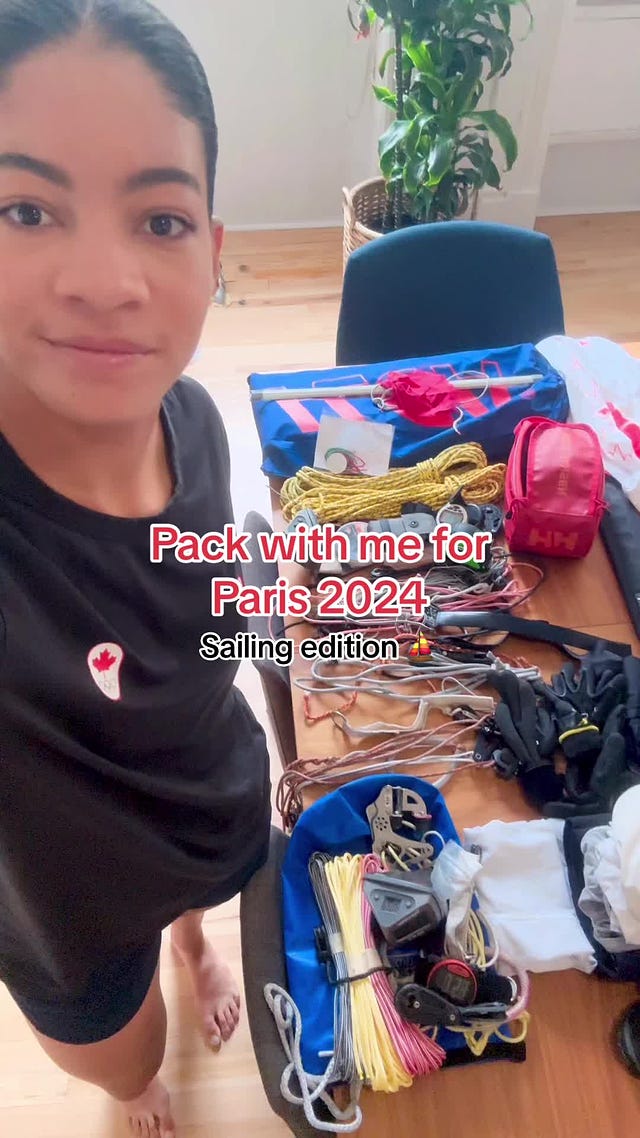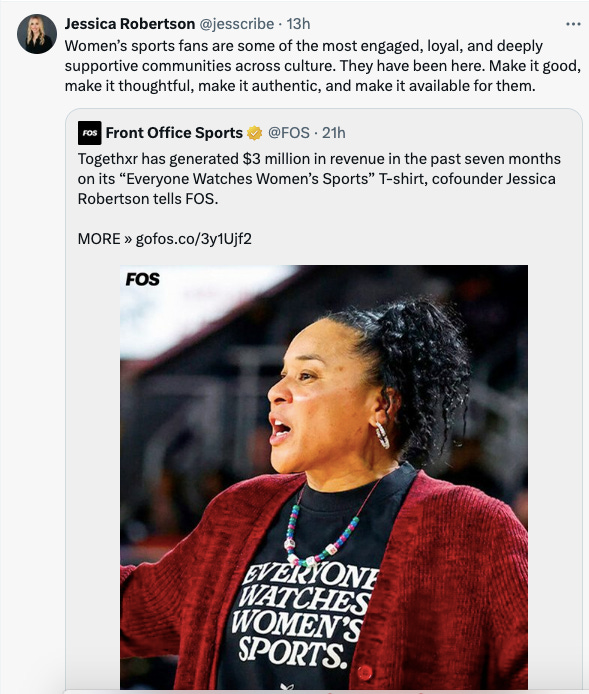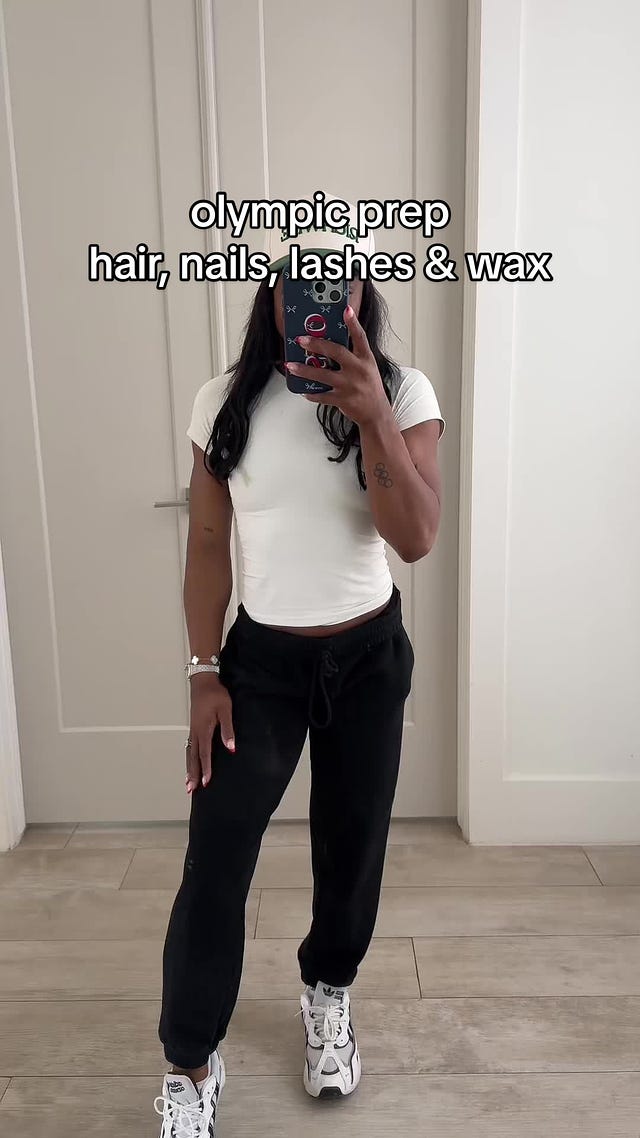The Beam is My Runway
An interview with a gymnast turned surgeon and some pre-Olympic Quick Thoughts
Dr. Sarah Brownlee is an elite gymnast turned Division 1 coxswain turned surgeon. So you could say she knows a bit about performing under pressure. With the Olympics in sight, I took the opportunity to pick her brain on gymnastics fashion and ask a few questions about how she dresses for the operating room. I loved this interview and hope you will too!
LG: How did you get started in gymnastics? Do you have any early memories of the gear you wore?
SB: I was a high-energy child. My mom took me to our local Y and put me in gymnastics classes around the age of 3, probably in the hopes that I would stop jumping/ running/ rolling around the house and all over the furniture. I do remember that I loved to get dressed for class, and later, team practice. For practice, we wore tank-style leos (no sleeves), and my favorite ones were made of crushed velvet. The ones I practiced in were pretty basic, usually just one or two colors and not much embellishment. But I did have one that was black crushed velvet and monogrammed in gold embroidery on the chest that I loved.1 There was also a very 90s phase where everyone used Dep hair gel and a rat tooth comb to get that slicked-back wet hair ballerina bun look, even for practice.
Once you were invited to join the team, dressing for practice and competitions became more serious. For practice, we all wore tank leos and hair had to be pulled back in a bun or simple ponytail. The process of getting your first “competition leo” was a really big deal. Everyone on the team, from level 10 to level 2, got measured and sized on the same day. Then they were sent for a big custom order, and it felt like it took them forever to come in. When they arrived (with our warm-up suits and slides and duffel bags) we all opened them together, tried them on, and took photos. I remember looking at the older girls and thinking it was so cool that I got to wear the same thing they did. Everyone got a long sleeve competition leo that was to be worn only for the actual competition, and then a few shorts leeve practice leos for practicing at the venue in the days leading up to the meet. These were all complimentary in colors and design but our competition leo was the showstopper.
Gymnasts are VERY superstitious. No matter how much you might love a particular leo, if you had a bad day (falls, an injury, just a terrible practice) while wearing it there was a good chance you’d never wear it again. Similarly, everyone had their lucky leo that they wore for a big day (trying to land a new skill, or just when needing some extra oomph to get through a hard week of training). This principle extended to hair accessories and other pieces of personal equipment (grips, wristbands, etc).
LG: How has gym style changed since you competed? Anything you like/dislike about today's style?
SB: You definitely don’t see a lot of crushed velvet anymore! And the embellishments have just gotten more and more flashy. I do like that there seems to be more individualism in what the elite athletes wear, and that some of them are having fun working with designers to express their own style (like Jordan Chiles).2 I never really felt like I had much say or choice in what I wore - the designs were decided on by the coaches according to what they thought would look and score best.
LG: Can we talk about gym hair/makeup? What was your approach? What strikes you about hair/makeup now?
SB: To be honest I never spent too much time on hair or makeup beyond a couple of ribbons or a scrunchie and maybe an eyeshadow that matched my leo. True to my current style I was always more of a minimalist. Now I think it’s much more involved and seen as part of your performance “armor”3, and people have different looks for different nights of competition.
LG: How comfortable is a leo? (Really I am asking: How do you prevent wedgies?)
SB: I think like any piece of performance wear there’s a little extra oomph that comes with putting on a competition leo. They always fit a little tighter than workout leos as a reminder to, as one of my coaches would say, “keep things high and tight". Wedgies are inevitable, but you do want to make sure they don’t happen on the competition floor. For that, I’ve seen athletes use everything from hairspray to liquid adhesive to get them to stay in place. Tuf-Skin spray was very popular on my team
LG: Are there any "rules" of gymnastics style that only true insiders know?
SB: Hmmm… at least when I was competing there was a “straps down for practice, up for competition” rule. It’s common to pull down the straps of tank leos during practice at your home gym but never at a competition venue.
LG: Does a great leo + good hair/makeup help your performance? What's the psychological impact of all this?
SB: I think like with anything else, you have to look good to feel good, and feeling good is important before any type of competition or pressure situation. And there is definitely something to the ritual of putting on gear, doing your hair and makeup, and feeling like you’re put together in a way that is special for that day and that performance. If nothing else, it’s a good activity to distract you from your nerves in the leadup to the meet starting...
LG: Switching gears, you're now a surgeon. While this isn't a sport per se, it is a profession that's all about performance. You're doing really precise work for hours on end. How do you dress for the OR?
SB: To anyone who has been an athlete, the OR can feel a lot like its own kind of sports arena. While everyone has to wear clean hospital-issued scrubs for infection control purposes, you can be picky about what you wear on your feet. Good compression socks and supportive clogs go a long way to combatting fatigue - Danskos are classic but Calzuros have taken off more recently, they’re lighter and come in more trendy colors like pastels. Cardiac surgeons (and anyone else who has a big enough ego) often wear white shoes as a kind of flex to show they never get blood on their shoes while operating. And a crisp clean white coat while rounding on the wards or in clinic is a must.
One thing that is often overlooked is that the lights are bright and hot, and you’re wearing a surgical gown, gloves, scrub cap, sometimes protective equipment like lead aprons (which are heavy), and sometimes surgical microscopes and/or a headlight. That’s a lot of gear to be wearing under hot lights. In some ORs where they have to also keep the room temp warm (think 90s F - pediatric cases, burn patients) we sometimes wear ice vests to avoid overheating too much if it’s a long case.
LG: What's missing from the market for surgeons, in particular female ones? (Do you wear sports bras?)
SB: Most female surgeons I know wear sports bras when operating - both for ease of movement and because of the heat issue mentioned above. Anything moisture-wicking is a plus during long cases.
There’s a lot missing from the market for female surgeons. It’s a very low bar. We are in a default-male world and everything from the scrubs we wear to the instruments we use are sized and styled accordingly. Brands like Figs that are direct to consumer and target health professionals with better fitting/ personalized scrubs and performance fabrics are interesting, but are perceived by surgeons as kind of frivolous and frankly unsanitary: unless you have personal laundry service at your hospital, you’re wearing them to and from work and bringing the hospital home with you.
Quick Thoughts
On continues to make a case for itself as the most innovative brand in running. The New York Time’s Vanessa Friedman covered the launch of the Cloudboom Strike LS, their new road racing shoe that is produced by an automated robot arm in 7 steps. Two things stood out to me. 1) I love that Hellen Obiri is the star of this debut. Sure, she’s On’s equivalent to Roger Federer for running but consider that the biggest comparative shoe launch is Nike’s 4%, which centered Eliud Kipchoge. Kipchoge’s sub-2 attempt was certainly deserving of the spotlight, but when was the last time a major running brand led a shoe launch with a woman as the defacto spokesperson WITHOUT making claims about the shoe being designed specifically for women’s feet? I like that On rightly recognizes that Obiri’s accomplishments stand alone and that men will buy this shoe because of them. 2) It’s interesting that Vanessa Friedman wrote the story. Her beat is style: She sits front row at Fashion Week, her analysis of Usha Vance’s clothing makes the front page, and she pens a weekly style advice column. There are any number of folks at the Times who could have covered the news from the sports to the business desk but Vanessa’s coverage underscores how closing running and fashion now overlap.
I guess then, I should have seen the front page of the Time’s Sunday Style section coming. Vanessa Friedman penned the story “For Fashion, Sports Stars Are the New Superstars,” in which she breaks down why athletes have emerged as the drivers of the fashion zeitgeist. One quote that stood out to me: “I’m sure more people see what Angel Reese or Caitlin Clark is wearing in the tunnel than are watching clips online,” Mr. Grede said. Then he added: “Why wouldn’t these extraordinary people known for their performance, embrace what Hollywood figured out 100 years ago? Fashion builds brands.”
Birkenstock is running (pun intended) a “Run Birkenstock Run” Campaign. This was a long time coming! Runners have been wearing Birkenstocks (with socks!) after their runs forever. When I was at Tracksmith they were my #1 collaboration target (and I am still annoyed we didn’t pull it off). Anyway, I like that they are showcasing athletes from run club culture vs influencers, it’s authentic to a campaign that’s rooted in customer insight.
Merit is a brand I reference constantly because of their commitment to storytelling and attention to detail. So I shouldn’t have been surprised that they were on top of creating content for the summer of sport, partnering with Allyson Felix to set a new record: a five-minute get ready with me on the treadmill. Part of me wishes this was done with a current Olympian, but the vagaries of the Trials process and Felix’s renown as both an athlete and an activist make her a wise selection.
This is a really smart and important advocacy campaign from Knix in collaboration with Meghan Rapinoe: Sport Your Period. Because 1 in 2 teens skips sports to hide their period, Knix is paying athletes to talk about menstruating in an effort to reduce the stigma. I’ll never forget the time I played with mine during a high school soccer game and was struggling with cramps. I asked our coach if I could be subbed out and told him point blank it was because of my period. He was a little taken aback, but my teammates were especially shocked. I learned to keep shut from then on. Even during college, it wasn’t something that was openly discussed as a potential barrier for performance. Kudos to Knix for clamoring for change.
A few other brands are going the advocacy route. If you don’t follow Bobbie, the organic baby formula company, you should – their content is best in class. Together with Clif Bar and track star Alysia Montaño’s &Mother, “Bring the Babies” is a campaign to support athletes with funds to travel with their children to the games.
Allyson Felix is making sure those mothers have support onsite as well, launching the first-ever nursery in the Olympic Village.
Figs is on the Olympic train. I liked their campaign for the Team USA medical team (the song choice is inspired) though it would have been cool to see them highlight Olympic athletes who work in medicine. There are more than you think…
Athletes continued to dominate magazine covers this week:
Marie Claire went deep in their Sport’s issue, with the WNBA’s A’Ja Wilson as their cover star.
I appreciated this inside look from Emma Child’s at how basketball player’s fashion choices come together: The Stylists Turning the Tunnel Walk into a Fashion Show
This isn’t in Marie Claire but it feels related from Vogue: Frankie De La Cretaz reports on the WAGs of Women’s Sports. Fun!
We’re in the heyday of women’s sports, but millennials were blessed with some iconic moments during the 90s and 2000s, which certainly helped fuel today’s momentum. Self was smart to tap into this nostalgia with their cover stars from the 1996 USA Women’s Gymnastics team. Christine Yu wrote the piece.
The Brits are also keen to celebrate athletes. In the Sunday Times Style:
And the Daily Mail’s You Magazine
Thank goodness the TikTok ban isn’t in effect yet, because the best content from the Olympics is almost certainly the athlete videos peppering my For You Page. I am curious about the psychological impact of engaging with social media during the Games. Is it a good distraction or a bad one? Are athletes who know they won’t win hedging their bets on social media stardom? Is it weird to see so many athletes doing Tiktok dances in front of the Olympic rings? Someone write this story for me please…
I stumbled on this TikTok from Canadian sailor Sarah Douglas. This is the content I love – a deep dive on the nuances of niche sports. It was interesting to learn what gear sailors are responsible for bringing vs. what is provided at the competition and how it all gets packed for travel.
Tiktok failed to load.
Enable 3rd party cookies or use another browser
Togethxr has made more than 3 million in “Everyone Watches Women’s Sport” tee shirt sales in 7 months. The hype is real: I bought my husband the French version and he was stopped 2x in one short walk by people wanting to talk about it.
Amen:
As anyone who has dated a pro or Olympic level athlete will tell you, they can be tough to be around. There’s a single-mindedness required that inevitably leads to selfishness. Honestly, it’s one of the best parts of being an elite athlete (and what can make retiring so hard). When else in life do you get to be so laser-focused on one singular goal? I like that Nike leaned into this psychology in their Olympic campaign. It’s spicy, in a good way.
For more on the evolution of gymnastics style, check out this 2016 Elle piece or this one from NCAA.com. I will be digging into this more!
I think this sense of freedom and fun with fashion may come in part from the fact that gymnasts are staying in the sport longer (more on this in The New Yorker). Older athletes may feel freer to showcase their own personal style versus follow the dictates of their coach. The power of social media is probably at play here too.












